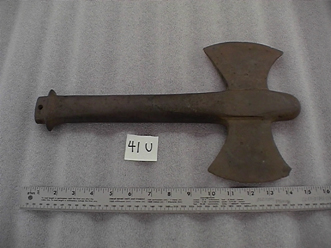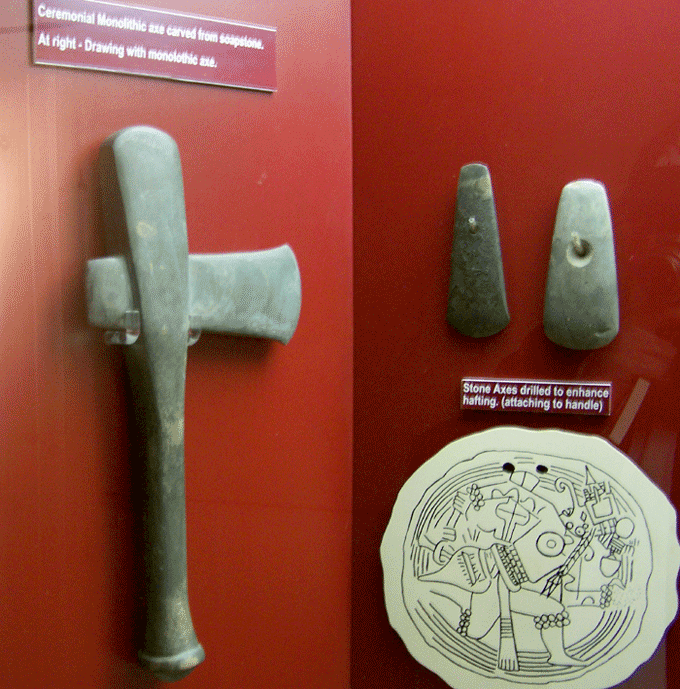Posts: 40 Location: Fargo, ND
Wed 19 Jan, 2011 8:37 am
Need help identifying axe-looking thing
Hello,
One of our local museums has this item and they aren't sure what it is or where it came from. It certainly looks like some kind of axe, but why not make a wood handle, and what's the deal with the hole at the end? Maybe this is a stylized anchor. I'm not sure, obviously. So, if you have some insight, please comment.
Thanks,
Tim
 Attachment: 75.43 KB
Attachment: 75.43 KB

Posts: 5,981 Location: Birmingham, Alabama
Wed 19 Jan, 2011 8:43 am
Looks like a Native American form to me. Not sure why it would be in iron, but possibly a ceremonial piece. Maybe early 20th c?
Posts: 813 Location: Windsor, Colorado
Wed 19 Jan, 2011 11:55 am
Rather mundane, but it reminds me of the paddles that go on mixers (something like a KitchenAid). Are the edges sharp? If it is sharp, I might lean more towards axe, but if they are not, then I'm thinking something boring like part of a butter churn.
-Greyson
Posts: 232
Wed 19 Jan, 2011 12:41 pm
Looking at the short tang I was thinking some kind of Finial. But seems kind of an odd thing for North Dakota.
I was going to ask if they had any idea of the time period it came from but it seems they are lacking any information as well.
Posts: 656
Wed 19 Jan, 2011 1:59 pm
Oh this is fun! Remember North Dakota is one of the few places on the planet where one can actually freeze in one's footprints! NOTHING should be considered strange there! The AXE mixer, perfect! I can see the infomercial now! You can make healthy drinks from storm damaged trees!
I like the finial idea, probably something late Victorian considering the location, maybe a cap for a post of an iron fence or a flag pole?
Hmm...... there was a fraternal organization called The Loyal Order of Foresters or something like that once, maybe it was a decoration on a club house?
Posts: 40 Location: Fargo, ND
Wed 19 Jan, 2011 2:25 pm
Here's an update:
It's actually made of stone that has been worked and smoothed. It was donated by a guy around 1960. He also donated Native American artifacts as well as other artifacts from Scandinavia, Ireland, and Scotland. So, the mystery continues, but I'm starting to think the blender idea is most sensible so far.
Thanks,
Tim
Posts: 1,973 Location: Nipmuc USA
Wed 19 Jan, 2011 4:30 pm
These folk are pretty good with spotting odd shapes and implements
http://forum.treasurenet.com/index.php?action=forum
Cheers
GC
Posts: 5,981 Location: Birmingham, Alabama
Wed 19 Jan, 2011 6:41 pm
My thought was that this looks like a steatite or greenstone axe, in iron. Now that I know it's stone I'm leaning even more toward NA. That was my field of study in another life and this looks very familiar to me...I just can't place it. :confused: I've seen a heap of Southeastern artifacts in books and museums, so maybe I'm recalling it from that.
Posts: 5,981 Location: Birmingham, Alabama
Wed 19 Jan, 2011 6:58 pm
Got it! Monolithic axes of similar form in the book, Sun Circles and Human Hands. Search for monolithic axe online and you'll see some. The examples in SSHH have the flared grip and pierced end. The vaguely European double-bit look of your example throws me, though, and makes me wonder if it might be one of a million forged artifacts. In the SE these are Mississippian culture artifacts. That culture bumped up against 16th c. Spanish explorers, so I guess it's at least theoretically possible a native saw a European axe and copied it in stone (these are ceremonial objects, not tools). That sort of cultural imitation is not unusual in following centuries--clay pots made to resemble European kettles, etc.
Posts: 40 Location: Fargo, ND
Wed 19 Jan, 2011 7:46 pm
| Sean Flynt wrote: |
| Got it! Monolithic axes of similar form in the book, Sun Circles and Human Hands. Search for monolithic axe online and you'll see some. The examples in SSHH have the flared grip and pierced end. The vaguely European double-bit look of your example throws me, though, and makes me wonder if it might be one of a million forged artifacts. In the SE these are Mississippian culture artifacts. That culture bumped up against 16th c. Spanish explorers, so I guess it's at least theoretically possible a native saw a European axe and copied it in stone (these are ceremonial objects, not tools). That sort of cultural imitation is not unusual in following centuries--clay pots made to resemble European kettles, etc. |
Sean, I think you are on to something. It's a start, for sure. Thanks for looking into it! -Tim
Posts: 656
Wed 19 Jan, 2011 8:06 pm
Tim Jorgensen opined, "..... I'm starting to think the blender idea is most sensible so far." Well, yeah, Tim but then you ARE from North Dakota! Sorry, as a former Minnesotan I couldn't resist ribbing someone about cold, etc.
Stone? Curiouser and curiouser. The collar and socket at the end of the haft make it similar to a machine part. It even appears that the socket is drilled for a pin to lock the joint together. Not that I think someone was building a stone tree chopper but maybe it was a part of a sculpture. One that disassembled for moving or something. The closest example I have of a somewhat similar concept is a Japanese wooden statue of the Buddha that I saw at the Rhode Island School of Design museum. It was a huge wooden statue and it was joined together with mortises and tenons like a piece of furniture. the head was fitted and tenoned to the neck and the arms to the shoulders maybe this axe is from a stone sculpture that is assembled in a similar way.
I'll have a black birch smoothie please!
Posts: 206 Location: The Netherlands
Thu 20 Jan, 2011 6:50 am
What about a dubbleheaded fasces that came from a statue or something...??
[ Linked Image ][/url]
http://www.burningground.org.uk/page6.htm
Posts: 5,981 Location: Birmingham, Alabama
Thu 20 Jan, 2011 6:54 am
An axe from Etowah(?):
 Attachment: 210.46 KB
Attachment: 210.46 KB

Posts: 242 Location: USA
Thu 20 Jan, 2011 4:00 pm
I agree with Sean, it looks like a Mississippian piece, probably ceremonial.
They made quite a few non-functional weapons for ceremonial purposes. Some of the more interesting (in my opinion) are the extremely long (for flint) blades at Etowah.
http://upload.wikimedia.org/wikipedia/commons....JPG[/url]
Posts: 656
Thu 20 Jan, 2011 6:23 pm
First, I make absolutely no claim to any professional knowledge about this kind of thing at all. I'm just going by what I see in a photo on my computer.
I don't think the artifact is from the culture Sean does, the axe blade looks too "19th century American" to me. I think it is a part of a stone sculpture but not stone age work.
So the question before us is, I suppose, do we just carry on wondering or is there a way that we (the local museum) can do something to find out? Could the museum send the piece to a university and get some expert opinions from archeologists, geologists and art historians? I think a geologist could do a lot to point things in the right direction. The type of stone would say a lot about the origins of the piece.
You
cannot post new topics in this forum
You
cannot reply to topics in this forum
You
cannot edit your posts in this forum
You
cannot delete your posts in this forum
You
cannot vote in polls in this forum
You
cannot attach files in this forum
You
can download files in this forum

